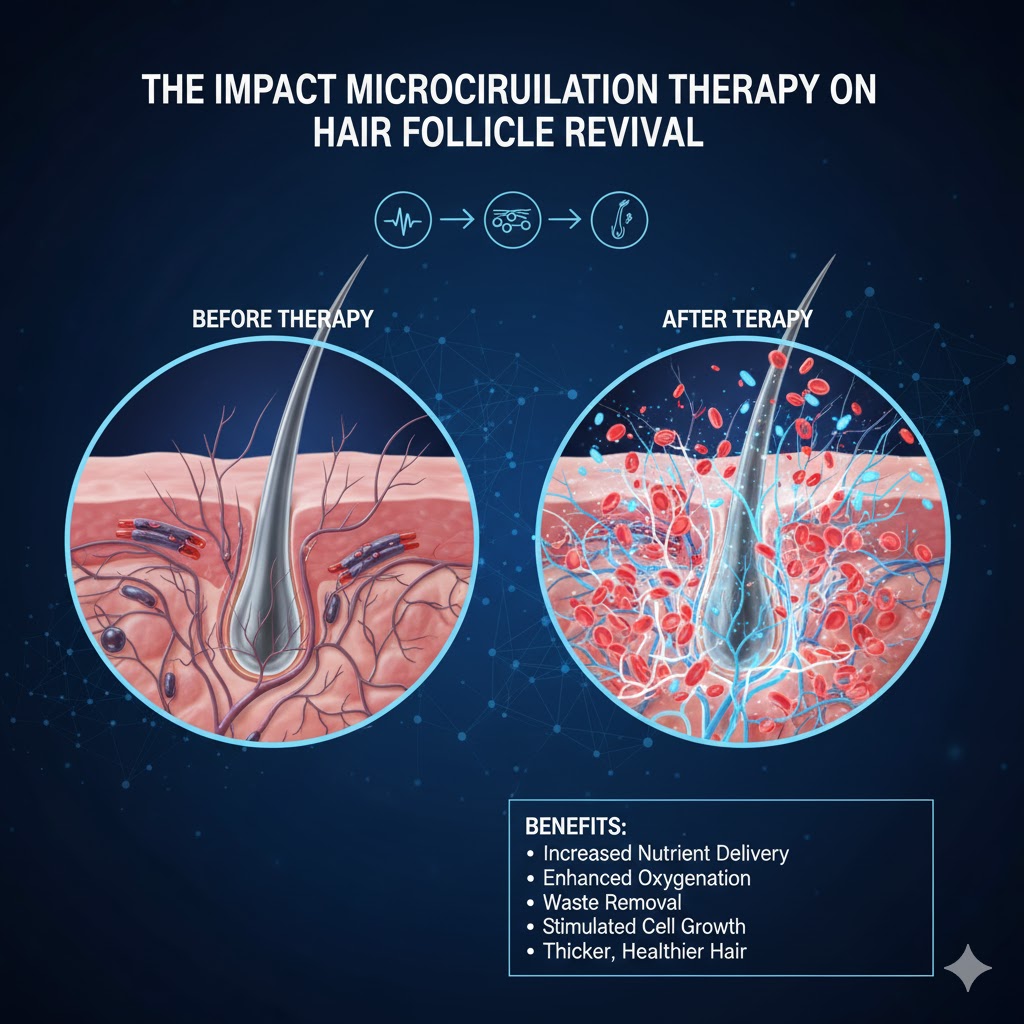Hair restoration is often discussed in terms of genetics, hormones, and transplant technology—but one critical factor is frequently overlooked: blood flow. More specifically, microcirculation. This intricate network of tiny blood vessels plays a vital role in delivering oxygen and nutrients to the scalp. Without it, even the healthiest hair follicles can fall dormant.
At ZMD Hair, we approach hair restoration from the inside out, beginning with the foundation of follicle vitality—circulation. In this blog, we explore the science behind microcirculation, how it affects hair growth, and how innovative therapy can revive even the most sluggish follicles.
What Is Microcirculation?
Microcirculation refers to the flow of blood through the smallest vessels in the body—capillaries, arterioles, and venules. These vessels are so small that red blood cells pass through them in single file. Their role? To exchange oxygen, nutrients, and waste between the bloodstream and surrounding tissues.
On the scalp, microcirculation is responsible for nourishing the hair follicle during every stage of its growth cycle. When blood flow is limited or impaired, follicles may receive insufficient oxygen and nutrients. Over time, this can lead to:
- Shortened growth cycles
- Miniaturization of follicles
- Thinner, weaker hair strands
- Premature shedding
In extreme cases, follicles may enter a prolonged dormant state and stop producing hair altogether.
Why Follicles Depend on Healthy Blood Flow
Hair follicles are highly metabolic structures. During the anagen (growth) phase, they require a steady supply of oxygen and nutrients to fuel cell division and keratin production. This demand increases as the hair shaft thickens and lengthens.
Poor microcirculation doesn’t just starve the follicle—it creates a hostile environment. Without adequate blood flow:
- Inflammatory byproducts accumulate
- Cellular waste is poorly removed
- Tissue oxygenation declines
- Stem cell activation is suppressed
All of these conditions make it more difficult for follicles to recover, even with advanced hair restoration treatments.
Causes of Impaired Scalp Microcirculation
Several factors can reduce blood flow to the scalp, including:
- Age: As we age, blood vessels lose elasticity, and circulation naturally declines.
- Hormones: Androgens like DHT can constrict vessels and reduce nutrient delivery.
- Stress: Chronic stress increases cortisol, which contributes to vasoconstriction.
- Poor diet: Nutritional deficiencies (iron, zinc, B vitamins) impair vascular health.
- Lifestyle factors: Smoking, lack of exercise, and high blood pressure all diminish microvascular efficiency.
Even tight hairstyles or prolonged pressure on certain areas of the scalp can impact local circulation.
What Is Microcirculation Therapy?
Microcirculation therapy refers to non-invasive treatments that aim to improve blood flow in the smallest vessels of the scalp. By enhancing oxygenation and nutrient delivery, these therapies promote a healthier environment for hair follicle revival.
At ZMD Hair, microcirculation therapy is often part of a comprehensive plan that includes regenerative treatments like PRP, LLLT, or FUE transplantation. Think of it as “priming the soil” before planting new seeds.
How Microcirculation Therapy Works
Several techniques are used to enhance scalp blood flow. Depending on a patient’s needs, our physicians may recommend:
1. Low-Level Laser Therapy (LLLT)
LLLT uses cold laser light to stimulate cellular metabolism and dilate blood vessels in the dermis. Research shows that laser light at specific wavelengths can:
- Increase ATP production in follicle cells
- Improve vascular permeability
- Promote endothelial growth (blood vessel repair)
- Prolong the anagen phase of hair growth
LLLT is pain-free, clinically tested, and FDA-cleared for hair loss.
2. Scalp Microneedling
Controlled micro-injuries created by microneedling stimulate wound-healing cascades. This increases collagen production and boosts blood flow through:
- Capillary remodeling
- Enhanced skin permeability
- Improved nutrient delivery
Microneedling also opens pathways for topical agents—like growth factors or peptides—to penetrate more deeply.
3. Topical Vasodilators
Certain compounds, such as minoxidil or natural peptides, work by widening blood vessels. When combined with microcirculation-enhancing devices, these agents can significantly improve local blood flow and follicle stimulation.
At ZMD Hair, we customize formulations to each patient’s sensitivity and goals.
Scientific Evidence Behind Microcirculation and Hair Growth
Recent studies support the relationship between microvascular health and follicle activity:
- Biopsies of balding scalps often show reduced capillary density and poor vascularization compared to healthy areas.
- In androgenetic alopecia, DHT accumulation correlates with lower scalp blood flow.
- LLLT and microneedling have been shown to increase vascular endothelial growth factor (VEGF), which promotes the formation of new capillaries.
- Improved blood flow has been linked to a prolonged anagen phase and increased hair shaft diameter.
These findings underscore the importance of circulation in both preventing and reversing hair loss.
When to Consider Microcirculation Therapy
Microcirculation therapy is most effective when:
- You’re noticing early signs of hair thinning
- Hair appears dull, dry, or brittle despite a healthy routine
- You’re preparing for or recovering from a hair transplant
- You want to maximize the results of PRP, LLLT, or other treatments
- You have a history of poor wound healing or inflammatory scalp conditions
It’s a proactive tool—not just a reactive one.
Integrating Microcirculation Into Your Hair Restoration Plan
At ZMD Hair, we don’t believe in cookie-cutter solutions. Every scalp is unique. That’s why we assess each patient’s vascular health, follicle density, and growth phase activity before recommending microcirculation therapies.
Our holistic approach may include:
- Microcirculation assessment using thermal imaging or Doppler scans
- Personalized therapy regimens using microneedling, LLLT, or vasodilators
- Targeted nutrition and supplements to support capillary health
- Regenerative treatments such as PRP or stem-cell derived serums
- Lifestyle coaching to reduce vascular stress (e.g., stress management, smoking cessation)
This integrative model ensures that we’re not just treating hair loss—we’re treating the scalp environment that fuels or suppresses growth.
Conclusion:
Hair loss doesn’t start at the surface—it begins deep within the skin, where blood vessels feed your follicles. Microcirculation therapy is more than a trend; it’s a foundational element of effective, science-backed hair restoration.
By improving blood flow to the scalp, you create an environment where hair can thrive—naturally, safely, and sustainably.
At ZMD Hair, we specialize in revitalizing the scalp from the inside out. Whether you’re exploring hair restoration for the first time or seeking to enhance previous treatments, microcirculation therapy may be the key to unlocking dormant growth potential.
📞 Book your personalized consultation today at ZMDHair.com or call us to learn how microcirculation therapy can jumpstart your follicle revival plan.




